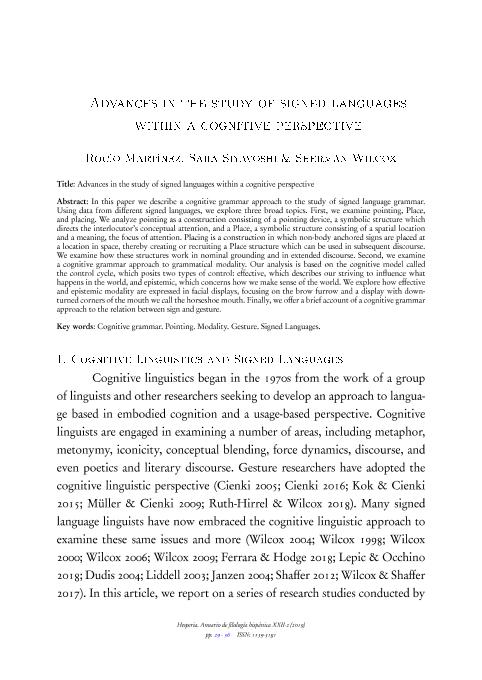Artículo
Advances in the study of signed languages within a cognitive perspective
Fecha de publicación:
03/2020
Editorial:
Universidad de Vigo
Revista:
Hesperia
ISSN:
1139-3181
Idioma:
Inglés
Tipo de recurso:
Artículo publicado
Clasificación temática:
Resumen
In this paper we describe a cognitive grammar approach to the study of signed language grammar. Using data from different signed languages, we explore three broad topics. First, we examine pointing, Place, and placing. We analyze pointing as a construction consisting of a pointing device, a symbolic structure which directs the interlocutor?s conceptual attention, and a Place, a symbolic structure consisting of a spatial location and a meaning, the focus of attention. Placing is a construction in which non-body anchored signs are placed at a location in space, thereby creating or recruiting a Place structure which can be used in subsequent discourse. We examine how these structures work in nominal grounding and in extended discourse. Second, we examine a cognitive grammar approach to grammatical modality. Our analysis is based on the cognitive model called the control cycle, which posits two types of control: effective, which describes our striving to influence what happens in the world, and epistemic, which concerns how we make sense of the world. We explore how effective and epistemic modality are expressed in facial displays, focusing on the brow furrow and a display with down-turned corners of the mouth we call the horseshoe mouth. Finally, we offer a brief account of a cognitive grammar approach to the relation between sign and gesture.
Palabras clave:
COGNITIVE GRAMMAR
,
POINTING
,
MODALITY
,
GESTURE
,
SIGNED LANGUAGES
Archivos asociados
Licencia
Identificadores
Colecciones
Articulos(SEDE CENTRAL)
Articulos de SEDE CENTRAL
Articulos de SEDE CENTRAL
Citación
Martínez, Rocío Anabel; Siyavoshi, Sara; Wilcox, Sherman; Advances in the study of signed languages within a cognitive perspective; Universidad de Vigo; Hesperia; 22; 3-2020; 29-56
Compartir
Altmétricas




